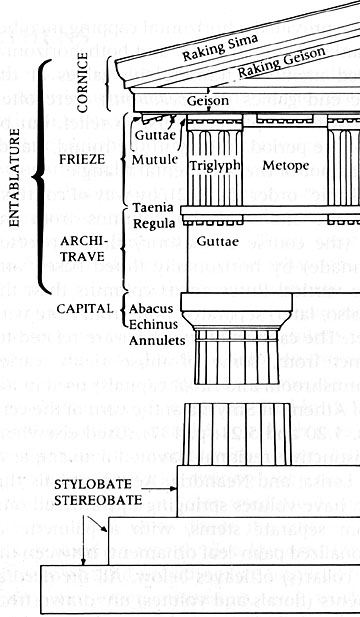|
Towards the end of the seventh and during the sixth century BCE evolved the two major styles of Greek architecture: DORIC and IONIC. Evidence indicates that the older Doric order did not appear until after the Greeks had made full contact with Egypt, which began in 664. The earliest representation of a Doric capital appears on a Protocorinthian sherd of about 650. The most characteristic building type in Greek architecture is the temple.
Rectangular plan for temples were already being adopted in the Geometric period, Their tructure was essentially a rectangular building (cella, or naos) that housed the cult statue, surrounded by a colonnade or peristyle. (Note: when the colonnade runs all the way around the cella, we refer to the temple as peripteral). Front and back porches (pronaos, opisthodomos) were formed by extending and thickening of the cella walls (antae; singular, anta). When two columns stand between the wall ends, described, in Latin, as being "in antis". A series of rules gradually developed which dictated general proportions, placement, and use of various decorative and functional members of the building.

Greek Temple plan
DORIC ORDER
Evolves through the Archaic period mostly in terms of refinements in proportion. Distinguishing characteristics of the Doric order are:
- A simple column shaft with twenty channels or flutes with sharp divisions (arrises) between them, and with three necking grooves near top. Slight convex tapering (entasis) from bottom to top
- The column stands directly on the stylobate, without a base.
- The capital has a swelling, cushion-like echinus, and a block-shaped slab for an abacus.
- The architrave is a continuous undecorated flat surface.
- The frieze has triglyphs ("three-grooved"), metopes, and regula-guttae and mutule-guttae constructions.

The Doric order
IONIC ORDER
Higher and more slender than the Doric, and more highly decorated. Earliest manifestations found in Ionia (Asia Minor). Distinguishing characteristics of the Ionic Order:
- The column shaft slender with twenty-four flutes separated by broad, flattened arrises.
- The column has an elaborately carved base.
- The capital consists of two hanging volutes, beneath which is an ornamental area, and above a thin abacus.
- The architrave carved with three flat undecorated projecting bands.
- The frieze is continuous flat surface that may been decorated with sculpture or painted.

The Ionic order
VOCABULARY
- Doric
- Ionic
- stylobate
- column
- flute
- capital
- echinus
- abacus
- architrave
- guttae
- entablature
- architrave
- frieze
- triglyph
- metope
- cornice
- pediment
- base
- volute
- naos or cella
- pronaos
- opisthodomos
- anta
- columns in antis
- peristyle or colonnade
- peripteral
|

 SPRING 2016
SPRING 2016  SCHEDULE
SCHEDULE  REQUIREMENTS
REQUIREMENTS

 SPRING 2016
SPRING 2016  SCHEDULE
SCHEDULE  REQUIREMENTS
REQUIREMENTS